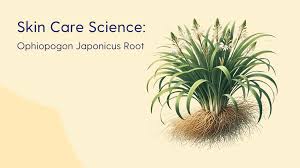
Ophiopogon Japonicus Root in Skin Care
You may see an ingredient called Ophiopogon japonicus root listed on many different skin care labels, including cleansers, moisturizers, and serums. This ingredient, commonly known as mondo grass or Japanese lily, or “Mai Dong” in traditional Chinese medicine, is known for its anti-inflammatory, antioxidant, and skin-soothing and hydrating properties.
Because it can help to repair the skin barrier and rehydrate the skin, Ophiopogon japonicus root extract is most commonly found in skin care products for dry skin, although it can be suitable for a range of Baumann Skin Types, depending on your skin’s specific needs.
Ophiopogon japonicus root extract has strong anti-inflammatory, antioxidant, and skin-hydrating benefits.
It’s usually well-tolerated by most skin types and doesn’t have notable side effects.
You’ll find it in a variety of cleansers, moisturizers and other products for barrier repair and dryness.
What Is Ophiopogon Japonicus Root?
Ophiopogon japonicus is a small, hardy grass native to East Asia, especially Japan, China, and Korea. Its root has long been used in traditional Chinese and Japanese medicine to support lung health, hydration, and immune function. In skin care, Ophiopogon japonicus root extract is used for its ability to promote a healthy skin barrier, improve hydration, soothe irritation, and protect against damage caused by oxidative stress.
Active Compounds in Ophiopogon Japonicus Root
Some of the most notable compounds in mondo grass that make it such a beneficial ingredient in skin care include:
Ophiopogonin is a type of plant compound called a saponin that is located in the root of the Ophiopogon japonicus plant. This compound is what gives this plant its strong anti-inflammatory, antioxidant, and even anti-cancer effects (3).
Polysaccharides , particularly β-fructans, found in mondo grass are believed to also contribute to this plant’s anti-inflammatory properties by reducing nitric oxide and certain inflammatory pathways (4). Additionally, polysaccharides are known for their ability to retain moisture, improving skin hydration and supporting its protective barrier.
Flavonoids like methylophiopogonanone A and methylophiopogonanone B are antioxidant-rich compounds found in mondo grass that effectively neutralize free radicals (5). This helps to protect the skin from oxidative stress that could otherwise result in premature aging and other unwanted effects.
Beta-sitosterol is plant-based sterol with soothing and anti-inflammatory properties. It is molecularly similar to cholesterol and helps to calm irritated skin and supports the health and function of the skin barrier.
Skin Benefits of Ophiopogon Japonicus Root
As you can see from the many beneficial plant compounds naturally found in Ophiopogon japonicus root extract, this ingredient comes with a number of benefits for the skin. These three are the most notable:
Anti-inflammatory properties. The bioactive saponins and plant sterols, particularly beta-sitosterol, found in mondo grass give this ingredient its strong anti-inflammatory properties. These compounds modulate inflammatory responses by inhibiting pathways associated with pro-inflammatory cytokine production, reducing visible redness and irritation. Studies suggest that these mechanisms can be especially beneficial for those with sensitive or reactive skin, helping to alleviate symptoms commonly associated with inflammatory conditions like rosacea and eczema (6)
Antioxidant properties. Flavonoids in Ophiopogon japonicus root neutralize reactive oxygen species (ROS) responsible for oxidative stress. Oxidative stress accelerates skin aging by damaging collagen and elastin, the proteins that give the skin its firm structure and elasticity. By reducing this damage, these antioxidants can protect against signs of premature skin aging like fine lines, wrinkles, and pigmentation issues.
Barrier repair and hydration. The polysaccharides in mondo grass improve the skin’s ability to retain moisture and strengthen its protective barrier. This process not only helps to prevent transepidermal water loss (TEWL) but also helps to keep irritants and allergens sealed out of the skin. Additionally, the saponins and plant sterols in this plant have been shown to contribute to healthy skin barrier function.
Side Effects of Ophiopogon Japonicus Root
Ophiopogon japonicus root is generally safe for topical use in most Baumann Skin Types. However, in some rare cases, this ingredient may cause mild skin irritation for some people, especially those with very sensitive skin.
Skin Care Products with Ophiopogon Japonicus Root Extract
You’ll often find Ophiopogon japonicus root in hydrating serums, moisturizers, and barrier-repair creams. Because of its soothing and moisturizing properties, Ophiopogon japonicus root extract is especially common in products designed for sensitive or dry skin types.
Below are just a few of my favorite high-quality skin care products that contain this ingredient.
Bottom Line
Ophiopogon japonicus root, also known as mondo grass, Japanese lily, or Mai Dong, is a plant-derived ingredient found in many cleansers, moisturizers, and serums aimed at improving barrier function and hydrating. In addition, this ingredient has strong anti-inflammatory and antioxidant properties, making it a beneficial ingredient for those with dry or sensitive skin.


